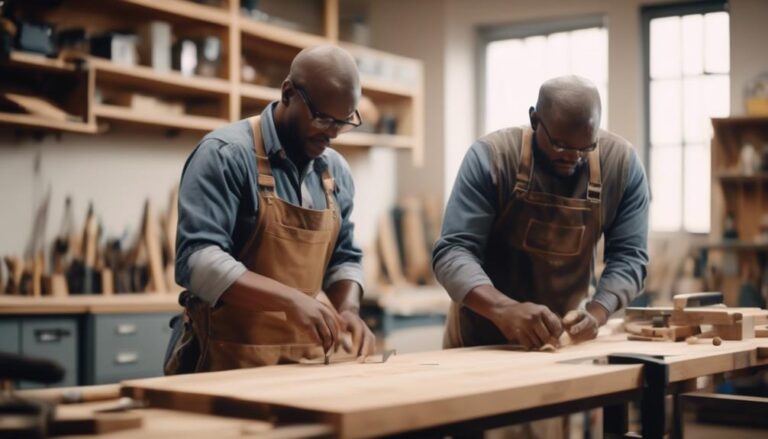Delving into the world of traditional South African joinery, many enthusiasts and professionals alike seek to uncover the secrets behind the durability and beauty of these time-honored techniques. With a landscape rich in diverse wood types, understanding how to harness the full potential of materials is a common challenge. The quest for knowledge on crafting joints that not only hold structures together but also carry the essence of South African heritage is what draws one into the depths of this fascinating subject.
Drawing from years of exploration and practice in the realm of woodworking, this article is poised to guide you through the intricate world of traditional South African joinery. With a focus tailored to those passionate about woodworking, we aim to bridge the gap between curiosity and expertise. By examining the fine details of dovetail and mortise and tenon joints, among others, we invite you on a journey that promises to enrich your understanding and appreciation of this craft.
As we venture further, rest assured that your quest for knowledge will be met with insights that resonate with your passion, encouraging you to read on and explore the captivating world of traditional South African joinery.
History of South African Joinery
The history of South African joinery is a fascinating blend of diverse cultural influences, resulting in a rich heritage of furniture design that showcases the unique craftsmanship and distinctive styles of different regions and tribes.
Traditional South African joinery methods have been passed down through generations, incorporating a variety of techniques and materials.
Wood, being abundant in South Africa, has been the primary material used in joinery. The African continent boasts a wide range of wood species, each with its own characteristics and qualities. From indigenous woods like African mahogany and yellowwood to exotic imports like teak and imbuia, South African joiners have utilized these resources to create furniture that is both functional and aesthetically pleasing.
Joinery techniques in South Africa have been influenced by various cultures. Dutch and Indonesian settlers brought their own methods, while British colonialism introduced new styles. The blending of these influences has resulted in unique wooden joints and joinery techniques that are specific to South African design.
The traditional joinery methods employed by different regions and tribes in South Africa reflect their cultural heritage. The Zulu, Xhosa, Ndebele, and Sotho tribes, among others, have developed their own distinctive styles, incorporating intricate carvings and decorative elements into their furniture.
The rich heritage of South African joinery is a testament to the skill and craftsmanship of its people. By preserving these traditional methods, South Africa embraces its cultural identity and ensures that its unique furniture designs continue to be celebrated and appreciated.
Traditional Joinery Techniques in South Africa
Incorporating time-honored methods and skilled craftsmanship, traditional joinery techniques in South Africa showcase the intricate artistry and structural integrity that have been passed down through generations. These techniques have been utilized in the creation of traditional African furniture, reflecting the heritage and artistic craftsmanship of the region. One of the most prominent methods used is the mortise and tenon joint, which involves a socket (mortise) and a protrusion (tenon) to create a strong and durable connection. Another common technique is the finger joint, where interlocking fingers are cut into the ends of two pieces of wood, creating a secure and visually appealing joint. The table below provides a comprehensive overview of various traditional joinery techniques used in South Africa:
| Joinery Technique | Description |
|---|---|
| Dovetail Joints | Classic and strong method used for drawer construction, offering excellent resistance to pulling apart and adding visual interest to the cabinetry. |
| Mortise and Tenon Joints | Used for centuries to create strong, stable connections, particularly suited for cabinet door frames and providing durability and stability to the cabinetry. |
| Box Joints | Similar to dovetails but with square interlocking fingers, providing a large glue surface area for strong connections and ensuring sturdy construction of the cabinetry. |
| Biscuit Joints | Utilizes oval-shaped, compressed wood biscuits and slots to align and strengthen joints, offering a reliable and hidden joinery option for secure connections in the cabinetry. |
These traditional joinery techniques continue to be embraced and celebrated in South Africa, not only in the creation of tribal furniture but also in contemporary designs that pay homage to the rich heritage of the region. The Art of Joinery in South Africa represents a blend of functionality and aesthetics, showcasing the mastery of the craftsmen who have honed their skills over generations. By incorporating these traditional joinery techniques, South African furniture makers ensure that each piece not only stands as a testament to their cultural legacy but also exhibits the structural integrity and beauty that have become synonymous with their craft.
Influences on South African Joinery Methods
The traditional joinery methods in South Africa have been heavily influenced by a convergence of Dutch, Indonesian, and British design styles. These influences have shaped the way wooden joints are used in South African furniture, resulting in a unique blend of traditional and modern African furniture design.
- Dutch Influence: The Dutch settlers who arrived in South Africa in the 17th century brought with them their expertise in furniture making. They introduced tenon joints, a technique where a projection on one piece of wood fits into a corresponding slot on another, creating a strong and durable connection. This technique is still widely used in South African furniture today.
- Indonesian Influence: The Indonesian artisans who were brought to South Africa as slaves also had a significant impact on joinery methods. They introduced intricate carving and decorative techniques, such as the use of mortise and tenon joints, which are commonly found in traditional African furniture.
- British Influence: The British colonization of South Africa in the 19th century introduced new furniture design styles, such as Queen Anne and Victorian. These styles emphasized ornate detailing and elegant craftsmanship, which influenced the joinery methods used in South African furniture.
- Rich Cultural Heritage: South Africa's diverse cultures and rich heritage have also influenced joinery methods. Different regions and tribes have their own unique furniture styles, such as the Zulu, Xhosa, Ndebele, and Sotho characteristics, each incorporating their own traditional joinery techniques.
The influences on South African joinery methods have resulted in a vibrant and diverse furniture design landscape, reflecting the country's rich cultural heritage and the skill and craftsmanship of its artisans.
Unique Features of South African Joinery
Building upon the influences of Dutch, Indonesian, and British design styles, the unique features of South African joinery methods showcase a rich blend of traditional craftsmanship and cultural heritage. Traditional South African joinery is renowned for its exquisite wooden furniture and intricate African design elements. The joints involved in South African joinery are carefully crafted and commonly used in the construction of furniture, ensuring excellent resistance and durability. Skilled craftsmen in South Africa have mastered traditional joinery techniques, which not only provide structural stability but also add a touch of uniqueness to each piece of furniture.
One of the most commonly used joints in South African joinery is the mortise and tenon joint. This joint involves a tenon, which is a protruding piece of wood, fitting into a mortise, a corresponding slot or hole. The mortise and tenon joint provides exceptional strength and stability, making it ideal for constructing furniture that can withstand the test of time. Another commonly used joint is the dovetail joint, which showcases the craftsmanship and skill of the South African artisans. This joint involves interlocking wedge-shaped protrusions, creating a strong bond that adds both structural integrity and aesthetic appeal to the furniture.
In addition to these joints, South African joinery also incorporates unique design elements inspired by the diverse cultures and traditions of the continent. Intricate carvings, patterns, and motifs are often incorporated into the furniture, showcasing the rich cultural heritage of South Africa. These design elements not only add beauty to the furniture but also serve as a way to connect with the African roots and create a sense of belonging for those who appreciate and admire South African joinery.
To provide a visual representation of the unique features of South African joinery, the following table showcases some commonly used joints and their characteristics:
| Joint Type | Description |
|---|---|
| Mortise and Tenon | Provides excellent strength and stability |
| Dovetail | Showcases craftsmanship and skill |
| Finger Joint | Creates a strong bond between two pieces of wood |
| Bridle Joint | Offers both strength and visual appeal |
| Halved Joint | Simple yet effective joint for connecting two pieces of wood |
Modern Applications of Traditional South African Joinery
Modern furniture designers are increasingly embracing and adapting traditional South African joinery techniques to create unique and visually striking contemporary woodwork. By incorporating these techniques into their designs, they not only pay homage to the rich history and cultural heritage of South Africa but also add a touch of elegance and aesthetic appeal to their pieces.
Here are some modern applications of traditional South African joinery:
- Protruding piece of wood: Designers are using this traditional technique to create eye-catching details in their furniture, such as decorative elements or functional features.
- Wa Africa Wooden: This technique involves the use of finger joints to connect wooden pieces seamlessly. It ensures the longevity of the furniture while adding a touch of artistic craftsmanship.
- Gained popularity: Traditional South African joinery has gained popularity in international exhibitions and events, where designers showcase their innovative use of these techniques. This helps to highlight the relevance of these techniques in modern woodworking.
- Tradition and modernity: Designers are finding ways to combine traditional South African joinery methods with modern interior design trends. This fusion of tradition and modernity creates unique and visually striking pieces that appeal to a wide range of audiences.




